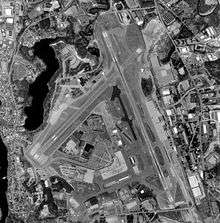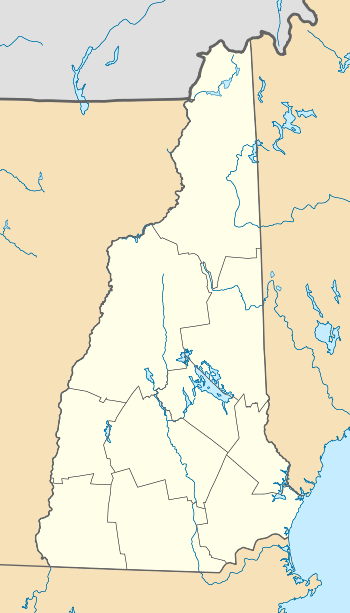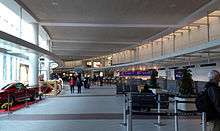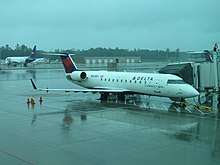Manchester–Boston Regional Airport
Manchester–Boston Regional Airport (IATA: MHT, ICAO: KMHT, FAA LID: MHT), commonly referred to as Manchester Airport, is a public airport 3 miles (5 km) south of the central business district of Manchester, New Hampshire, United States,[1] on the border of Hillsborough and Rockingham counties. The airport lies in two communities, Manchester and Londonderry.
Manchester–Boston Regional Airport | |||||||||||||||
|---|---|---|---|---|---|---|---|---|---|---|---|---|---|---|---|
 Air photo taken 11 April 1998 | |||||||||||||||
| Summary | |||||||||||||||
| Airport type | Public | ||||||||||||||
| Owner | City of Manchester | ||||||||||||||
| Serves | Manchester, New Hampshire | ||||||||||||||
| Location | Manchester and Londonderry, New Hampshire, U.S. | ||||||||||||||
| Hub for | Wiggins Airways | ||||||||||||||
| Elevation AMSL | 266 ft / 81 m | ||||||||||||||
| Coordinates | 42°55′57″N 071°26′08″W | ||||||||||||||
| Website | www | ||||||||||||||
| Map | |||||||||||||||
 MHT Location of airport in New Hampshire/United States  MHT MHT (the United States) | |||||||||||||||
| Runways | |||||||||||||||
| |||||||||||||||
| Statistics | |||||||||||||||
| |||||||||||||||
Founded in 1927, it moved more than 1 million passengers in a year for the first time in 1997. After years of growth it handled 4.33 million passengers in 2005, its peak year. Passenger tallies have declined since then in common with many regional airports; it handled 1.85 million passengers in 2018.[2] Manchester–Boston Regional Airport is by far the busiest airport in New Hampshire and the only one with substantial commercial service. It is also New England's fifth-largest airport by passenger volume, behind Boston Logan in Massachusetts, Bradley International in Connecticut, T. F. Green in Rhode Island, and Portland International Jetport in Maine.
It is included in the Federal Aviation Administration (FAA) National Plan of Integrated Airport Systems for 2017–2021, in which it is categorized as a small hub primary commercial service facility.[3]
The facility was known as Manchester Airport until April 18, 2006, when it added "Boston Regional" to advertise its proximity to Boston, about 50 miles (80 km) to the south.
Certified for Cat III B Instrument Landing operations, the airport has a reputation for never surrendering to bad weather. The airport has closed only once, when the national airspace was shut down for two days following the September 11 terrorist attacks, and all American airports were required to close.[4]
It is home to the Aviation Museum of New Hampshire, built around an Art Deco control tower and terminal opened in 1938.
Use
Manchester–Boston is New England's third-largest cargo airport. Only Connecticut's Bradley International, which is a hub for UPS Airlines, and Logan exceed it in terms of cargo handled. In 2005, the airport processed 150 million pounds of freight. Most of this was carried aboard aircraft flown by FedEx, UPS, and DHL. All three serve Manchester with large, cargo-specific jets, including the Airbus A300, DC-10, and MD-11 by FedEx and UPS.
UPS uses Manchester to "feed" the rest of northern New England by contracting with Wiggins Airways,[5] which flies smaller prop-driven planes to places like Portland, Augusta, Bangor, Presque Isle, Rutland, and other communities. To handle this "regional sort", UPS built a sorting facility where packages coming in from the company's Louisville hub are redistributed to trucks or to the Wiggins feeder aircraft. FedEx previously used Manchester as a regional sorting station as well, but now supports the northern New England destinations via direct flights from Memphis, Tennessee to Portland and Burlington. A contract with the Postal Service fills the FedEx jets (coming from hubs in Memphis and Indianapolis) with mail in addition to the typical assortment of express and overnight packages. DHL previously operated a 727-200 on a Wilmington, Ohio-Allentown, Pennsylvania-Manchester-Wilmington routing, but that service has since ceased.
Facility and operations
Manchester Airport covers an area of 1,500 acres (610 ha) which contains two asphalt runways: Runway 17/35 measuring 9,250 x 150 ft (2,819 x 46 m) and Runway 6/24 measuring 7,650 x 150 ft (2,332 x 46 m).[1]
For the 12-month period ending January 31, 2018, the airport had 50,539 aircraft operations, an average of 138 per day: 42% commercial, 32% air taxi, 25% general aviation, and 1% military. In January 2018, there were 67 aircraft based at this airport: 44 single-engine, 4 multi-engine, 15 jet, and 4 helicopter.[1]
History

The Manchester airport was founded in June 1927, when the city's Board of Mayor and Aldermen put $15,000 towards the project. By October, a board of aviation had been founded and ground was broken at an 84-acre (34 ha) site near Pine Island Pond. It took only a month for two 1,800-foot (550 m) runways to be constructed. The board of aviation convinced George G. "Scotty" Wilson, a barnstormer operating out of Boston, to move to New Hampshire and start Manchester's first flying service. After the formation of Northeast Airways at the site in 1933, the first passenger terminal was built.
The current Manchester airport began to take shape as a joint civil-military facility in the 1960s. The first major development at MHT was the construction of a new civilian terminal, and the first modern air traffic control tower in New Hampshire, in 1961. Roscoe A. Ammon, a successful businessman, donated $500,000 for the construction of the new civilian air terminal. Unfortunately, Roscoe Ammon died of cancer less than two weeks before the terminal was opened, and thus missed the opportunity to see the product of his generous donation. A new passenger terminal was later built in 1994. In 1966, the Air Force removed its remaining forces and closed Grenier Air Force Base, leaving the airport open for expansion. In 1978 the airfield was renamed Manchester Airport.
Throughout the 1960s and 1970s, the airport was served by Northeast Airlines with the CV-240, DC-9, and FH-227. Delta Air Lines absorbed Northeast in 1972 and continued to serve the airport with the DC-9 until 1978, then 727-200s until 1980 when it discontinued service at Manchester. In the mid-1980s, airlines once again started offering jet service out of Manchester. United Airlines inaugurated service at Manchester in 1983 with two daily flights to Chicago–O'Hare. This was part of their 50 States campaign, which positioned United as the only carrier to serve all 50 states with mainline service. The Boeing 727 and Boeing 737 were initially used on the Chicago flights, which would often make intermediate stops in cities like Providence, Albany, Syracuse, and Burlington, to pick up or drop off passengers. Manchester was also a "tag-on" for United flights heading from Bangor and Portland, Maine, to Chicago, but the carrier no longer serves either city with mainline aircraft.
In the early 1990s, United Airlines began flights between Manchester and Washington Dulles International Airport near Washington, D.C. But creation of a north–south hub at Dulles did not work for United, and heavy competition in this market led to a quick exit. The Boeing 737 was used for this short-lived service, which comprised about four daily circuits between the two airports. US Airways started service at Manchester in early 1986, by connecting their hubs at Pittsburgh and Philadelphia. The carrier used the DC-9, BAC 111, and 737-200 aircraft. Both carriers expanded service at Manchester over the years with larger planes and more flights. United now runs a strict non-stop schedule to and from Chicago with no intermediate stops or tag-ons. The 757 has been used by both United and US Airways at Manchester, which stands as the largest passenger-carrying plane to serve the airport in scheduled service. The Airbus A320 series of aircraft is also commonly used by United, Northwest Airlines (merged with Delta Air Lines), and occasionally by US Airways. In April 2010, Delta enhanced service to Manchester; it dropped its daily CRJ-700 service to Atlanta and replaced the aircraft with an MD-88 with seating for 149. Delta also switched all its Delta Connection service to Detroit with mainline service on DC-9's. Delta, American Arlines and Southwest are the only airlines serving Manchester with mainline jets, Southwest is the only airline to only use mainline jets with the Boeing 737-700 and the Boeing 737-800.
Expansion

In 1992, a long-term expansion and improvement plan started to take shape. Two years later, a new 158,000-square-foot (14,700 m2) terminal designed by HNTB and Lavallee Brensinger opened, providing ample room for larger jets.[6] The airport continued to expand, opening a new parking garage and parking lots in the next years, as well as working to reconstruct the runways and taxiways. In 1998, these expansions paid off, with MetroJet, Northwest, and Southwest all beginning service. The airport has prospered from the "Southwest Effect", in which competing airlines increase service and decrease fares to compete with the low-cost carrier. Throughout the 1990s, Manchester outpaced almost every other similarly-sized airport in terms of passenger growth. In 2003, Runway 17/35 was extended from 7,001 feet (2,134 m) to 9,250 feet (2,820 m), allowing non-stop service to Las Vegas.
In April 2006, the aldermen of the city of Manchester voted to change the name of the airport to "Manchester–Boston Regional Airport" in an effort to increase its visibility to travelers around the country.[7]
Decline in passengers
In 2006 the airport started to experience a decrease in passengers flying through its facility, with service to only twelve cities. In 2017, the airport served the fewest passengers since 1998. Southwest as of 2019 has diminished service to five cities, with Delta Air Lines serving Atlanta once daily instead of twice. United Airlines cancelled their O'Hare service in July 2018, making Newark their only destination from Manchester, which was replaced by Washington Dulles in March 2019.
The decline in service is due to increased activity at Logan International Airport in Boston and to mergers between airlines, which led to decreased flights. When Southwest entered Logan in 2009, it also significantly reduced prices at Logan, prompting more people to fly out of Boston rather than Manchester.[8]

Current service
In 2019, American Airlines announced service to Chicago O'Hare, and United announced service to Washington-Dulles in March 2019.
The airport administration hired a new Airport Director[9] to help it bring back passengers to Manchester, as well as to help bring in new airlines and destinations.[8]
Airlines and destinations





Passenger
| Airlines | Destinations |
|---|---|
| American Airlines | Seasonal: Philadelphia |
| American Eagle | Charlotte, Chicago–O'Hare, Philadelphia, Washington–National |
| Delta Air Lines | Seasonal: Atlanta |
| Delta Connection | Detroit, New York–LaGuardia |
| Southwest Airlines | Baltimore, Chicago–Midway, Orlando, Tampa Seasonal: Fort Lauderdale |
| United Express | Washington–Dulles[10] |
Destinations map
| Destinations map |
|---|
 Manchester Atlanta Washington–Dulles Baltimore Destinations from Manchester-Boston Regional Airport (Red) = Year-round destination (Green) = Seasonal destination |
Cargo
| Airlines | Destinations |
|---|---|
| FedEx Express | Memphis, Buffalo Seasonal: Hartford, Indianapolis |
| FedEx Feeder operated by Wiggins Airways | Bangor, Barre/Montpelier, Burlington (VT), Hartford, Portland (ME), Presque Isle, Rockland, Rutland, Waterville (ME) |
| UPS Airlines | Hartford, Louisville, Philadelphia Seasonal: Syracuse, Chicago/Rockford, Ontario |
Statistics
Top destinations
| Rank | Airport | Passengers | Carriers |
|---|---|---|---|
| 1 | Baltimore, Maryland | 243,980 | Southwest |
| 2 | Chicago–Midway, Illinois | 107,230 | Southwest |
| 3 | Philadelphia, Pennsylvania | 100,130 | American |
| 4 | Orlando, Florida | 94,510 | Southwest |
| 5 | Charlotte, North Carolina | 66,580 | American |
| 6 | Detroit, Michigan | 60,230 | Delta |
| 7 | Washington–National, D.C. | 59,980 | American |
| 8 | Tampa, Florida | 59,380 | Southwest |
| 9 | Atlanta, Georgia | 43,690 | Delta |
| 10 | Newark, New Jersey | 36,780 | United |
Carrier shares
| Carrier | Passengers (arriving and departing) |
|---|---|
| Southwest | 1,152,000(59.13%) |
| Republic | 156,000(8.02%) |
| PSA | 156,000(7.73%) |
| ExpressJet | 132,000(6.79%) |
| Delta | 100,000(5.15%) |
| Other | 275,000(13.18%) |
Annual traffic
| 1990s | 2000s | 2010s | ||||||
|---|---|---|---|---|---|---|---|---|
| Year | Passengers | Change | Year | Passengers | Change | Year | Passengers | Change |
| 2000 | 3,169,301 | 2010 | 2,814,432 | |||||
| 2001 | 3,233,555 | 2011 | 2,710,747 | |||||
| 1992 | 840,361 | 2002 | 3,366,834 | 2012 | 2,452,064 | |||
| 1993 | 794,134 | 2003 | 3,601,661 | 2013 | 2,422,102 | |||
| 1994 | 919,914 | 2004 | 4,003,307 | 2014 | 2,095,674 | |||
| 1995 | 893,326 | 2005 | 4,329,478 | 2015 | 2,077,064 | |||
| 1996 | 984,130 | 2006 | 3,896,532 | 2016 | 2,021,279 | |||
| 1997 | 1,108,216 | 2007 | 3,892,630 | 2017 | 1,970,688 | |||
| 1998 | 1,938,089 | 2008 | 3,716,393 | 2018 | 1,847,908 | |||
| 1999 | 2,809,089 | 2009 | 3,181,249 | 2019 | 1,727,532 | |||
Ground transport
Highway access
In 2007, construction began on Raymond Wieczorek Drive (then known as Manchester Airport Access Road), an expressway connection from the F.E. Everett Turnpike.[14] Before this project, access to the airport was limited to local roads off Interstate 293/NH Route 101. The access road opened on November 10, 2011, connecting the airport and NH Route 3A in Litchfield with the Everett Turnpike and U.S. Route 3 in Bedford.[15]
Manchester Shuttle
From November 13, 2006, to June 30, 2008, the airport operated a shuttle bus — free to ticketed passengers — that ran every two hours, 24 hours a day, to the Anderson Regional Transportation Center in Woburn, Massachusetts (45 minutes), on to the Sullivan Square subway station in Boston (75 minutes), and back to the airport via Woburn.[16] The free service shut down after a private company, Flight Line Inc., began operating a paid service along similar routes on July 1, 2008. Flight Line offers hourly service between the airport, several points in northern Massachusetts, and the city of Boston for $39 each way. Reservations are required.[17]
Greyhound Lines
Greyhound buses offer three trips daily from Manchester Airport on its Boston–Montreal service. Buses serve Concord and Hanover in New Hampshire; White River Junction, Montpelier, and Burlington in Vermont; and Saint-Jean-sur-Richelieu and Montreal in Quebec, Canada, when going northbound. They serve South Station and Logan International Airport in Boston on the southbound trips.
Local bus service
The Manchester Transit Authority provides hourly bus service between the passenger terminal and downtown Manchester.
Rail extension
The Massachusetts Bay Transportation Authority has proposed to extend the Lowell Line of its commuter rail system to Manchester including Manchester airport. This is only a proposal, and no funds have been allocated for the project as of 2016.[18]
The New Hampshire State Rail Plan of 2012 stated that freight could also be viable on the rail extension, perhaps opening up more freight opportunities for the airport.[19]
Law enforcement / security
The town of Londonderry's police are responsible for law enforcement and security operations at the airport terminal. The sheriff's department of Rockingham County was responsible for law enforcement operations at the airport until 2006 when the Londonderry Police Department was awarded the new security contract.
Incidents
Sunday, June 3, 1928 - At 3:02 pm, Lt. George Wilson's Curtiss OX-5 nosedived 40 feet (12 m) and crashed at the south end of the airport while landing before thousands of onlookers. Wilson received a gash on the face, and one passenger was pinned in the wreckage and sustained shock, cuts and bruises. The cause of the crash was motor failure, and the plane was badly crumpled with its nose buried deeply in a swamp.
Sunday, February 19, 1933 - Real N. Bourke died when the Arrow Sport two-seater he had hired from Northeast Airways burst into flames a quarter mile north of Manchester Airport on the Boone Farm. He had made a number of steep banks and wing-overs, and his landing gear struck a gully prior to the crash. It was Manchester's first fatality.
Friday, August 5, 1938 - At about 6:15 pm, student pilot Avalon Robert Lilly Jr. was injured when a WACO biplane, powered by a Wright Whirlwind motor, attempted a loop 400 feet (120 m) off the ground, but fell and crashed 200 feet (61 m) from the Manchester Airport Administration Building. The plane belonged to Donald Lewis, who was at the controls and suffered major injuries. Lilly later died on August 12, 1938.
Thursday, December 10, 1942 - A fighter plane connected to Manchester Airport (Grenier Field) crashed in Mont Vernon around noontime; the unidentified pilot was uninjured.
Monday, April 24, 1944 - At 9:00am, a four-motored Army B-24 Liberator bomber (#42-5111) took off from Manchester Airport and crashed into a densely wooded area on Fort Mountain near Epsom, killing all 10 crew on board.
Wednesday, November 29, 1944 - At 9:30am, another Army B-24L (#44-49669) crashed nose-first in Pawtuckaway State Forest in Nottingham, 16 miles (26 km) northeast of Manchester, killing all nine crew. It had taken off from Manchester and was headed to Gander, Newfoundland, Canada.
Thursday, August 5, 1948 - At 5:00 pm, an AT-11 training plane and an A-26 attack bomber collided over Manchester airport, killing four.
Tuesday, July 31, 1973 - Delta Air Lines Flight 723 from Burlington, Vermont, to Boston was diverted to Manchester to pick up passengers stranded by a flight cancellation. After leaving Manchester it continued to Boston, but during landing there the McDonnell Douglas DC-9-31 hit a sea wall at the end of Runway 4, killing 83 passengers and 6 crew.[20]
Solar panels
In 2012, south-facing solar panels were installed on the roof of the parking garage, but they caused so much glare for the nearby control tower for 45 minutes each morning that they were removed, and later replaced with 2,210 panels (460 kW AC) that were reoriented to the east to eliminate the glare. The airport expects to save $100,000 each year on electricity by having the solar panels. The efficiency of east or west facing panels is reduced by about 10%, so more panels were added so the total generation would be about the same. The array is expected to generate about 585,000 kWh each year.[21][22][23]
References
- FAA Airport Master Record for MHT (Form 5010 PDF), effective May 25, 2017
- Union-Leader: "Airport loses altitude in passenger numbers"
- "List of NPIAS Airports" (PDF). FAA.gov. Federal Aviation Administration. 21 October 2016. Retrieved 27 November 2016.
- Edward W. Browder, Jr. and Maurice B. Quirin, Manchester's Airport: Flying Through Time, pp. 329-330. ISBN 0-9721489-9-X
- "Wiggins Airways' Aircraft Flight Operations". Archived from the original on May 12, 2008. Retrieved 2008-08-09.
- Lavallee Brensinger - Manchester/Boston Regional Airport Archived 2011-11-22 at the Wayback Machine
- "04/18/2006 Board of Mayor and Aldermen Meeting Minutes" (PDF). Retrieved 20 September 2014.
- ""Airport Director working to get new Low-Cost Airline"". Retrieved 7 May 2019.
- "New Airport Director MHT". Retrieved 15 May 2019.
- "United Ending Newark Service, replacing with Dulles". Retrieved 18 October 2018.
- "Manchester, NH: Manchester-Boston Regional (MHT)". Bureau of Transportation Statistics. February 2017. Retrieved May 29, 2017.
- About (Passenger & Cargo Statistics). Retrieved on Apr 3, 2015.
- Manchester-Boston Regional Airport Expansion Serves As Catalyst For Growth. Retrieved on Nov 13, 2016.
- "Manchester Airport Access Road Project 11512 - Overall Plan" (PDF). NH Department of Transportation.
- Nashua Telegraph article on opening
- "Airport Announces Free Bus Service Between Woburn and Boston For Ticketed Passengers". Archived from the original on 2007-05-05. Retrieved 2006-11-14.
- "Manchester Shuttle Pilot Program Proves Successful! Private Ground Transportation Company to Offer High Frequency, Affordable Service to Northern Massachusetts and Boston". Archived from the original on 2008-07-16. Retrieved 2008-07-18.
- Lowell Sun "Push on to extend rail service from Lowell into NH" 02/04/2015
- Final State Rail Plan 2012
- Brouder, Edward W., Jr, et al. Manchester's Airport: Flying Through Time. Amherst NH: New Hampshire Aviation Historical Society, 2006.
- Solar Project
- Manchester airport remains in dark over solar-panel glare solution
- "Manchester-Boston Regional Airport: Parking Garage Solar PV Facilty". Vale Clean Technology. Retrieved March 22, 2016.
External links
- Official website
- Historic American Engineering Record (HAER) No. NH-32, "Manchester Airport, South of downtown Manchester, east of Route 3A & Pine Island Pond, Manchester, Hillsborough County, NH"
- FAA Airport Diagram (PDF), effective June 18, 2020
- Resources for this airport:
- AirNav airport information for KMHT
- ASN accident history for MHT
- FlightAware airport information and live flight tracker
- NOAA/NWS weather observations: current, past three days
- SkyVector aeronautical chart for KMHT
- FAA current MHT delay information